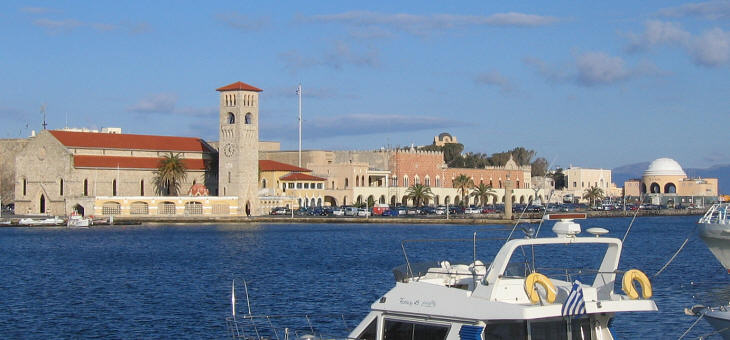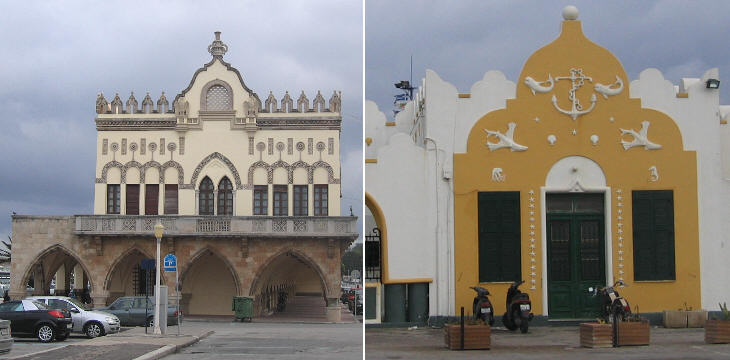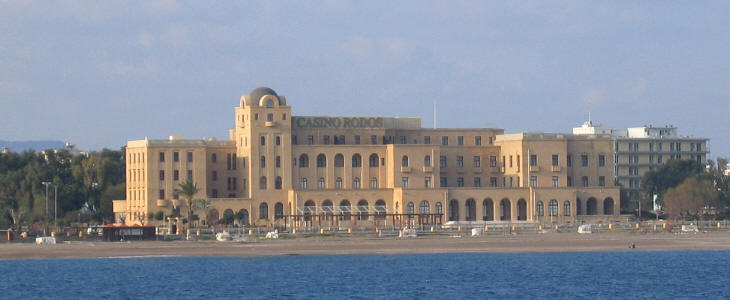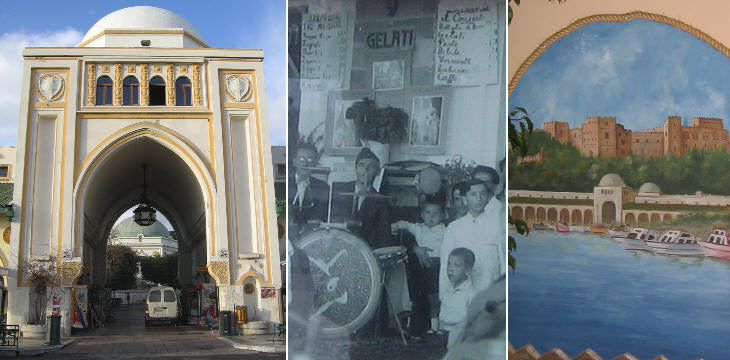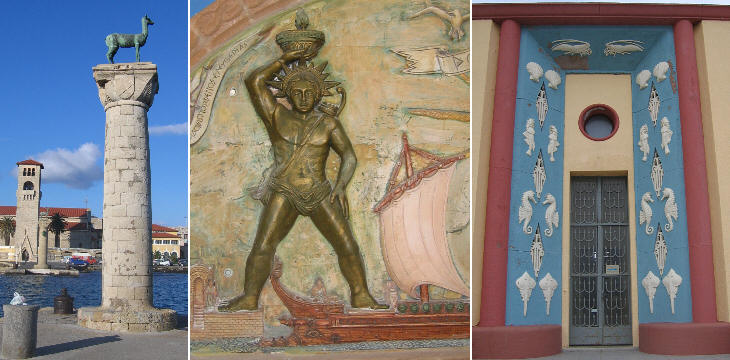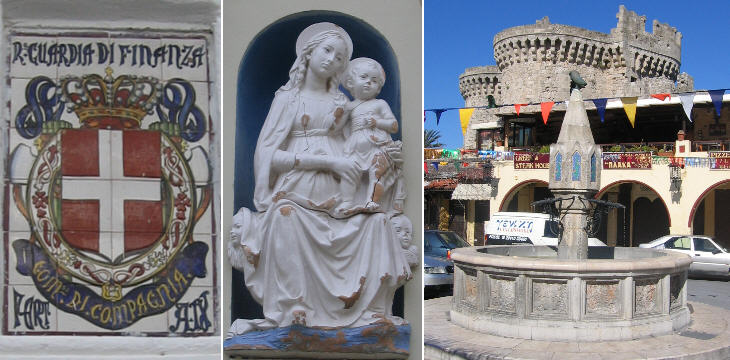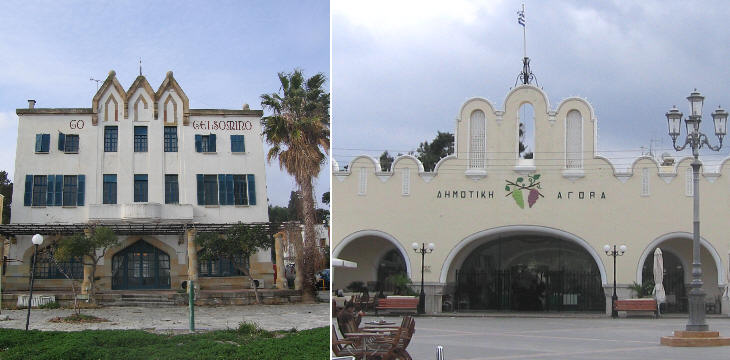  What's New! Detailed Sitemap All images © by Roberto Piperno, owner of the domain. Write to romapip@quipo.it. Text edited by Rosamie Moore. Page added in March 2007. |
 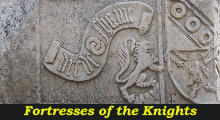 Italian Architecture in Rhodes Italian Architecture in Rhodes(relief in the fortress of Bodrum) In September 1911 the Kingdom of Italy declared war on the Ottoman Empire with the objective of conquering the three remaining provinces that empire had in Africa and which today are known as the Republic of Libya. Italy hoped to find an alternative destination for its excess population (in the period 1906-10 3,256,000 Italians had left their country). The conquest of Libya turned out to be more difficult than expected: the Turks had just small garrisons and the towns along the coast were easily occupied, but the local Arab leaders maintained control of the interior. In May 1912 in order to stop supplies of weapons to Libya and to force the Ottoman Empire to ask for peace, the Italians, who had total naval supremacy, landed on Rhodes and in a matter of days occupied the island: they then landed on Kos and ten other nearby islands: these islands which were called southern Sporades were renamed Dodecanese (twelve islands), their current name.
The Italo-Turkish War ended in October 1912 mainly because Greece, Serbia, Bulgaria and Montenegro, having seen the weakness of the Ottoman Empire, attacked it (First Balkan War): the state of war in the area continued with a second Balkan War in 1913, World War I (1914-18) and eventually the war between the Republic of Turkey and Greece. A final settlement was not reached until July 1923 with the Treaty of Lausanne: Rhodes and the Dodecanese became an Italian possession, which included also a thirteenth island: Castelrosso (Kastelorizo), a tiny island very near the mainland. So the Dodecanese was no longer an accurate name to indicate the islands, but because number 13 according to most Italians brings bad luck, the 13 islands continued to be called the Dodecanese.
During the period 1912-20 the Dodecanese were under military rule which was followed by a civil administration headed by a governor who had great authority. In 1923 this position was assigned to Mario Lago, a career diplomat who was involved in drafting the Lausanne Peace Treaty. The Dodecanese were not formally designated as a colony: their status was more similar to some French possessions (Reunion, Guadeloupe, Martinique); Lago envisaged an action plan to develop the resources of the islands and immediately understood their potential as a tourist resort.
Neo Chorio where the Greeks lived was turned into a modern town, while the buildings of historical Rhodes were restored and the Hospital housed an archaeological museum. Among the Italian architects who designed modern Rhodes, the Roman architect Florestano di Fausto played a major role. He designed buildings which were in line with the governor's objective of attracting a rich clientele. A very large hotel was built on the sandy beach at the very tip of the island. It was named Albergo delle Rose because the advertising campaign claimed that roses in Rhodes were in blossom ten months a year and the island was also called Isola delle Rose.
Rhodes was very popular among the upper classes of cosmopolitan cities like Beirut in Lebanon and Alexandria in Egypt. Di Fausto designed a modern new market surrounded by cafÚs which replaced the old bazaar. Its design pleased the guests who came from Europe in search of a One Thousand and One Nights atmosphere.
Mario Lago was governor of Rhodes until 1934; during that period relations with the largely prevailing Greek community were relatively good, taking into account that the governor was the representative of a very authoritarian and nationalist regime. Children had to attend schools where they were taught Italian, but they could learn Greek at religious institutions. At the cafÚs pricelists were affixed both in Italian and Greek.
The Italian administration placed two columns at the entrance of Mandraki, which was the harbour of Ancient Rhodes, on the assumed site of the feet of the Colossus of Rhodes. This bronze statue was one of the Seven Wonders of the World: it portrayed Helios, the Greek God of the Sun; according to the traditional iconography the Colossus was spread-legged and ships passed beneath it (but today it is generally thought the statue stood on one side of the harbour). It held a torch and the head was surrounded by rays. If an inhabitant of Ancient Rhodes were to arrive at New York by sea, he would most likely think that Manhattan is a colony of Rhodes, because the Statue of Liberty has many points in common with the Colossus.
In December 1936 Mario Lago was replaced by Cesare De Vecchi, a very early leader of the Fascist party. He found the cosmopolitan atmosphere of Rhodes too far from the nationalist one prevailing in Italy. De Vecchi abolished the tribunals which following the Ottoman tradition ruled over matters related to the various religious communities; Greek newspapers were closed; Italian was imposed as the only authorized language. The new governor was not pleased with the appearance of many modern buildings and he ordered Albergo delle Rose stripped of the ornate decorations designed by Di Fausto. On the site of the Palace of the Grand Masters he built a gigantic mansion, meant to be used by the King or by il Duce (the title given to Mussolini) during their visits to the island (they never went there). He placed his own coat of arms next to that of the Grand Masters and set his residence in the new palace.
The other islands of the Dodecanese also retain modern buildings designed by Italian architects. The image used as background for this page shows a stucco in the modern town Move to: Introductory page Rhodes: the Gates Rhodes: the Fortifications Rhodes: the Town of the Knights Rhodes: Byzantine, Ottoman and Jewish memories Kos: the fortress Kos: the ancient town St Peter's Castle (Bodrum) Castelrosso Calimno Lero Symi Nissiros Lindos Other fortresses Fortress of the Orthodox church Patmo (Patmos) Clickable Map of the Ionian and Aegean Seas with links to other locations covered in this website (opens in a separate window)  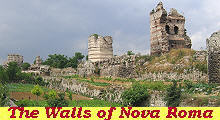  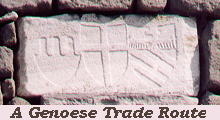 |
